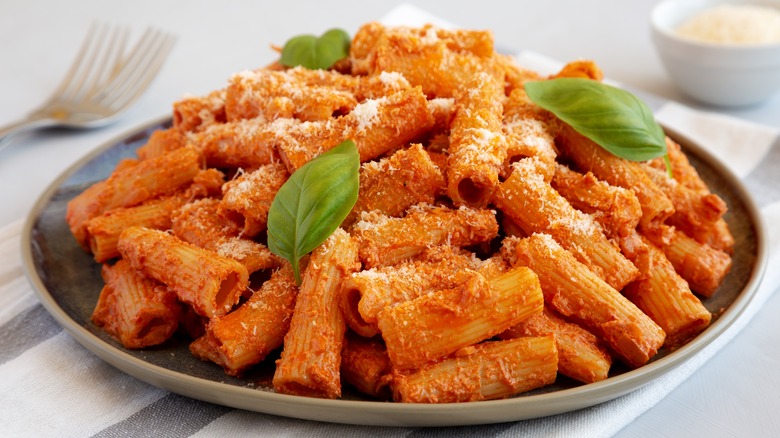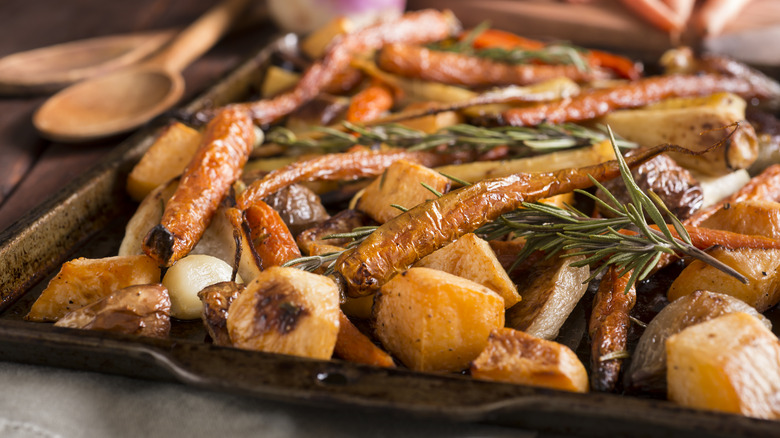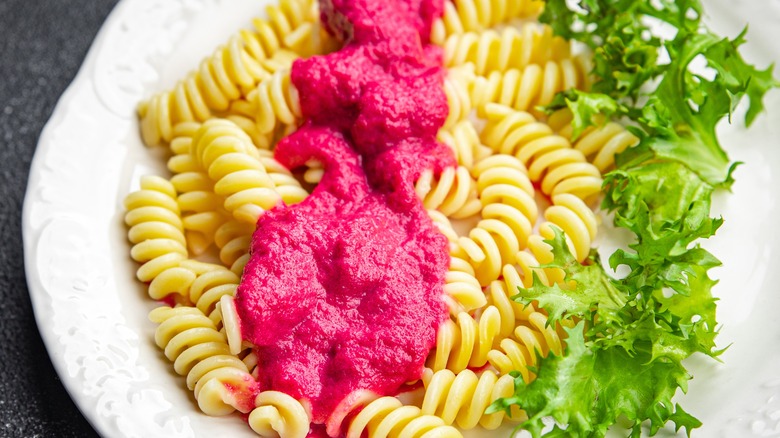The Tomato Swap For Satisfying Spaghetti Sauce
Tomatoes are the cornerstone of many favorite recipes, like pasta, pizza, salsa, and so much more. However, not everyone enjoys or can tolerate the fruit in their diet. Regardless of the reason, you don't need to deprive yourself of comfort foods if you can't eat tomatoes since there are delicious, easy swaps you can make — especially when it comes to a satisfying spaghetti sauce.
Typically, a basic tomato sauce is made with minimal ingredients such as onions, garlic, and, of course, lots of seeded tomatoes. As the tomatoes break down, a rich sauce develops, which can be used immediately or simmered for hours. But, there are other veggies that will work in the same way if you don't want tomatoes as the base.
Carrots, which also contain glutamate, are the perfect substitution for tomato's high concentration of umami. The root vegetable is already commonly found in marinara recipes, adding sweetness and savoriness to the sauce. Since carrots alone would be too sweet, a true 1:1 swap won't recreate the same taste and mouthfeel. Instead, balance out the taste and thicken the consistency by also including eggplant.
The sponge-like fruit breaks down like a tomato, creating a thick sauce similar to marinara. Combined with aromatics and herbs, this tomato-free sauce is so satisfying that you'll want crusty bread to sop up every last drop left in your bowl.
Tips for preparing a non-tomato spaghetti sauce
The cooking technique is the same for most tomato-based spaghetti sauces — typically the ingredients are sauteed until soft and then simmered until the desired consistency is met. Rather than sauteing the ingredients for a tomato-free sauce, however, it's better to slow-roast vegetables like carrots and eggplants in the oven. Roasting intensifies their flavor and sweetness, and will give the finished product more depth.
Cooking the spaghetti sauce in the oven is also gentler than sauteing the ingredients over direct heat. It gives root veggies more time to soften and minimizes the risk of burning any added onions or garlic. However, while everything can go into the oven together, be mindful of the different cooking times.
To avoid bitter garlic, cut the carrots and eggplant into smaller pieces since they take longer to roast, and keep the garlic cloves whole. Remember, don't crowd the pan so the ingredients can caramelize, and be sure not to scrap all the fond and oil left in the roasting pan as it contains tons of flavor.
Once the veggies are caramelized and tender, puree everything in a blender, adding water or stock until the sauce is smooth. If necessary, balance out the sauce's sweetness by adding acidity (a drop of lemon juice or vinegar). Once the spaghetti is al dente, all that's left is to pass around the grated Parmigiano-Reggiano.
Additional tomato swaps for spaghetti sauce
If you can't eat tomatoes due to an allergy or intolerance, you may have also eliminated eggplant from your diet since they are both in the nightshade family. Fortunately, there are other veggies that you can use to make a delicious pasta sauce, with beets at the top of the list. You can certainly use golden beets, but red beetroot gives the sauce a deep crimson color like a marinara that's been simmering all day long.
Once roasted, beets are sweet and tender, adding body to the sauce. Since they are difficult to peel raw, roast the beets whole until they are knife-tender and then rub off their papery skin. You can also incorporate potatoes into the sauce. Each starchy variety will help thicken the puree, but if you prefer a sweeter sauce (or are looking to use it for pizzas), select yams or sweet potatoes. For a smooth consistency, make sure you peel them before roasting.
In addition, it never hurts to have a few tricks up your sleeve to adjust the taste. A splash of soy or Worcestershire sauce makes a big impact and deepens the spaghetti sauce's color. Similarly, anchovy paste or simmering with a parmesan cheese rind imparts a lot of umami. Whichever path you choose, don't forget to incorporate some pasta water at the end so your silky sauce clings to the noodles.



